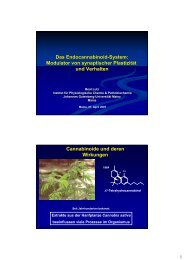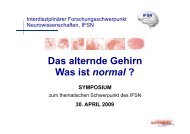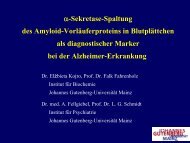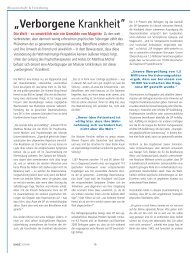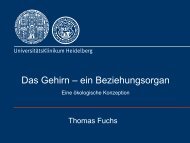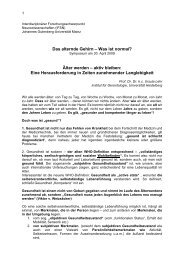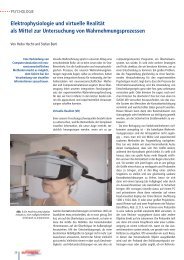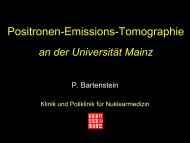Prof. Dr. rer. nat. Christian Behl - IFZN
Prof. Dr. rer. nat. Christian Behl - IFZN
Prof. Dr. rer. nat. Christian Behl - IFZN
Create successful ePaper yourself
Turn your PDF publications into a flip-book with our unique Google optimized e-Paper software.
<strong>Prof</strong>. <strong>Dr</strong>. <strong>rer</strong>. <strong>nat</strong>. <strong>Christian</strong> <strong>Behl</strong><br />
Curriculum vitae<br />
Education and academic positions<br />
1982 – 1988, Study of Biology at the Julius Maximilians University Würzburg; July 1988, Diploma (cum<br />
laude); 1988 – 1991, PhD thesis in the laboratory of <strong>Prof</strong>. <strong>Dr</strong>. E. Buchner (Institute for Genetic) and<br />
<strong>Prof</strong>. <strong>Dr</strong>. U. Bogdahn (Department for Tumour Biology) at the Neurological Hospital Würzburg;<br />
December 1991, PhD degree (magna cum laude); 1991 – 1992, Postdoctoral Fellow at the<br />
Neurological Hospital Würzburg; 1992 – 1994 Postdoctoral Researcher at the Salk Institute for<br />
Biological Studies in San Diego (<strong>Prof</strong>. <strong>Dr</strong>. D. Schubert), USA; 1994 – 1996, Research Scientist, Head<br />
of the Steroidpharmacology Group at the Max Planck Institute for Psychiatry Munich (Director: <strong>Prof</strong>. <strong>Dr</strong>.<br />
<strong>Dr</strong>. F. Holsboer); 1997 – 2002 Head (C3) of an Independent Max Planck Society Research Group at<br />
the Max Planck Institute for Psychiatry Munich; since June 2002 Full <strong>Prof</strong>essor (C4) for<br />
Pathobiochemistry, University Mainz, and Chair of the Department of Pathobiochemistry; since<br />
January 2003 Executive Director of the Institute for Physiological Chemistry & Pathobiochemistry,<br />
University Mainz; since August 2005 Chair of the Interdisciplinary Research Centre for Neurosciences<br />
(<strong>IFZN</strong>) of the Johannes Gutenberg University Mainz<br />
Current position<br />
Full <strong>Prof</strong>essor for Pathobiochemistry (C4), Institute for Physiological Chemistry & Pathobiochemistry,<br />
Johannes Gutenberg University Mainz; Executive Director of the Institute for Physiological Chemistry &<br />
Pathobiochemistry; Chair of the Interdisciplinary Research Centre for Neurosciences (<strong>IFZN</strong>) of the<br />
Johannes Gutenberg University Mainz<br />
Research interests<br />
Neurodegenerative disorders, biochemistry of ageing<br />
Memberships and professional functions<br />
Member of the Scientific Advisory Board of the Journal of Neural Transmission (since 1997) and of the<br />
European College of Neuropsychopharmacology, ECNP (since 2003); Member of the Executive<br />
Committee of the Society for Applied Vitamin Research, GVF (since 2002), Advisory Board of the<br />
“Hirnliga e.V.” (since 2005); Member of the American Society for Neuroscience; the New York<br />
Academy of Sciences; the German Society of Neurosciences; the “Arbeitsgemeinschaft<br />
Neuropsychopharmakologie und Pharmakopsychiatrie” (AGNP); the German Society for Biological<br />
Psychiatry<br />
Honors and awards<br />
1995, Award of the German Hirnliga e.V.; 1998, Organon Research Award for Biological Psychiatry;<br />
1999 HERMES Vitamin Award; 2003 AGNP Award for Psychopharmacology Research by the Lilly Co.<br />
Publications (as at Spring 2007)<br />
Total number of publications: 123<br />
Publications in: J Biol Chem (6), Mol Pharmacol (3), Science (1), Endocrinology (3) and others<br />
Original articles since 2002<br />
1. <strong>Behl</strong> C (2002) Estrogen can protect neurons: modes of action. J Steroid Biochem 83: 195-197.<br />
2. Zschocke J, Manthey D, Bayatti N, van der Burg B, Goodenough S, <strong>Behl</strong> C (2002) Estrogen<br />
receptor alpha-mediated silencing of caveolin gene expression in neuronal cells. J Biol Chem<br />
277:38772-38780.<br />
3. <strong>Behl</strong> C, Moosmann B (2002) Oxidative nerve cell death in Alzheimer’s disease and stroke:<br />
antioxidants as neuroprotective compounds. Biol Chem 383: 521-536.
4. <strong>Behl</strong> C, Moosmann B (2002) Antioxidant neuroprotection in Alzheimer’s disease as preventive and<br />
therapeutic approach. Free Radical Bio Med 33: 182-191.<br />
5. Moosmann B, <strong>Behl</strong> C (2002) Secretory peptide hormones are biochemical antioxidants: structureactivity<br />
relationship. Mol Pharmacol 61: 260-268.<br />
6. Marsicano G, Moosmann B, Hermann H, Lutz B, <strong>Behl</strong> C (2002) Neuroprotective properties of<br />
cannabinoids against oxidative stress: role of the cannabinoid receptor CB1. J Neurochem 80:<br />
448-456.<br />
7. Marsicano G*, Goodenough S*, Monory K, Hermann H, Eder M, Cannich A, Azad SC, Cascio MG,<br />
Gutierrez SO, van der Stelt M, López-Rodriguez ML, Casanova E, Schütz G, Zieglgänsberger W,<br />
Di Marzo V, <strong>Behl</strong> C*, Lutz B* (2003) [ * equal contributions] CB1 cannabinoid receptors and ondemand<br />
defense against excitotoxicity. Science, 302: 84-88.<br />
8. Bayatti N, Zschocke J, <strong>Behl</strong> C (2003) Brain region-specific neuroprotective action and signaling of<br />
corticotropin-releasing hormone in primary neurons. Endocrinology 144: 4051-4060.<br />
9. Goodenough S, Schäfer M, <strong>Behl</strong> C (2003) Estrogen-induced cell signalling in a cellular model of<br />
Alzheimer's disease. J Steroid Biochem 84: 301-305.<br />
10. Zschocke J, Manthey D, Bayatti N, <strong>Behl</strong> C (2003) Functional interaction of estrogen receptor alpha<br />
and caveolin isoforms in neuronal SK-N-MC cells. J Steroid Biochem 84: 167-170.<br />
11. Zitzler J, Link D, Schäfer R, Liebetrau W, Kazinski M, Bonin-Debs A, <strong>Behl</strong> C, Buckel P, Brinkmann<br />
U (2004) High-throughput functional genomics identifies genes that ameliorate toxicity due to<br />
oxidative stress in neuronal HT-22 cells: GFPT2 protects cells against peroxide. Mol Cell<br />
Proteomics 3, 834-840.<br />
12. Schäfer M, Goodenough S, Moosmann B, <strong>Behl</strong> C (2004) Inhibition of glycogen synthase kinase<br />
3ß is involved in the resistance to oxidative stress in neuronal HT22 cells. Brain Res 1005, 84-89.<br />
13. van de Stolpe A, Slycke AJ, Reinders MO, Zomer AW, Goodenough S, <strong>Behl</strong> C, Seasholtz AF, van<br />
der Saag PT (2004) Estrogen receptor (ER)-mediated transcriptional regulation of the human<br />
corticotropin-releasing hormone-binding protein promoter: differential effects of ERα and ERβ. Mol<br />
Endocrinol 18, 2908-2923.<br />
14. Goodenough S, Conrad S, Skutella T, <strong>Behl</strong> C (2004) Inactivation of glycogen synthase protects<br />
against kainic acid-induced neurotoxicity in vivo.�kinase-3ß Brain Res 1026, 116-125.<br />
15. Zschocke J, Bayatti N, Clement AM, Witan H, Figiel M, Engele J, <strong>Behl</strong> C (2005) Differential<br />
promotion of glutamate transporter expression and function by glucocorticoids in astrocytes from<br />
various brain regions. J Biol Chem 280, 34924-34932.<br />
16. Ludemann N, Clement A, Hans VH, Leschik J, <strong>Behl</strong> C, Brandt R (2005) O-glycosylation of the tail<br />
domain of neurofilament protein M in human neurons and in spinal cord tissue of a rat model of<br />
amyotrophic lateral sclerosis (ALS). J Biol Chem 280, 31648-31658.<br />
17. Goodenough S, Schleusner D, Pietrzik C, Skutella T, <strong>Behl</strong> C (2005) Glycogen synthase kinase 3ß<br />
links neuroprotection by 17ß-estradiol to key Alzheimer processes. Neuroscience 132, 581-589.<br />
18. Zschocke J, Bayatti N, <strong>Behl</strong> C (2005) Caveolin and GLT-1 gene expression is reciprocally<br />
regulated in primary astrocytes: association of GLT-1 with non-caveolar lipid rafts. Glia 49, 275-<br />
287.<br />
19. Bayatti N, Hermann H, Lutz B, <strong>Behl</strong> C (2005) Corticotropin-releasing hormone-mediated induction<br />
of intracellular signaling pathways and brain-derived neurotrophic factor expression is inhibited by<br />
the activation of the endocannabinoid system. Endocrinology 146, 1205-1213.<br />
20. Gamerdinger M, Manthey D, <strong>Behl</strong> C (2006) Estrogen receptor subtype-specific repression of<br />
calpain expression and calpain enzymatic activity-implications for neuroprotection against Ca 2+ -<br />
mediated excitotoxicity. J Neurochem 97(1), 57-68.<br />
21. Manthey D, <strong>Behl</strong> C (2006) From structural biochemistry to expression profiling: Neuroprotective<br />
activities of estrogen. Neuroscience 138(3), 845-850.<br />
22. Kern A, Roempp B, Prager K, Walter J, <strong>Behl</strong> C (2006) Down-regulation of endogenous amyloid<br />
precursor protein processing due to cellular aging. J Biol Chem 281(5), 2405-2413.<br />
23. Moosmann B, <strong>Behl</strong> C (2007) Mitochondrial encoded cystein predicts animal lifespan. Aging Cell, in<br />
re-review
24. Ebinger M, <strong>Behl</strong> C, Rosenhagen M, Uhr M (2007) P-glycoprotein has Negligible Effects on<br />
Estradiol and Testosterone in Mice. Neurosci Lett, in press<br />
25. Clement AB, Hanstein R, Schröder A, Nagel H, Fahrenholz F, <strong>Behl</strong> C (2007) Effects of neuron<br />
specific ADAM10 modulation in an in vivo model of acute excitotoxic stress. Neuroscience, in <strong>rer</strong>eview<br />
26. Gamerdinger M, Clement AB, <strong>Behl</strong> C (2007) Cholesterol-like effects of selective cyclooxygenase<br />
inhibitors and fibrates on cellular membranes and amyloid-beta production. Mol Pharmacol 72(1):<br />
141-151<br />
27. Kuhlmann CRW, Tamaki R, Gamerdinger M, Lessmann V, <strong>Behl</strong> C, Kempski OS, Luhmann HJ<br />
(2007) Inhibition of the myosin light chain kinase prevents hypoxia-induced blood brain barrier<br />
disruption. J Neurochem (April 10), in press<br />
Reviews and book chapters<br />
28. <strong>Behl</strong> C (2002) Neuroprotective strategies in Alzheimer’s disease. Adv Exp Med Biol 513: 475-496.<br />
29. <strong>Behl</strong> C (2002) Sex hormones, neuroprotection and cognition. Prog Brain Res 138:135-142.<br />
30. Moosmann B, <strong>Behl</strong> C (2002) Antioxidants as treatment for neurodegenerative disorders. Expert<br />
Opin Inv <strong>Dr</strong>ug 11:1407-1435.<br />
31. <strong>Behl</strong> C (2002) Estrogen as a neuroprotective hormone. Nat Rev Neurosci 3: 433-442.<br />
32. <strong>Behl</strong> C (2002) Neuroprotective effects of estrogens in the central nervous system: mechanisms of<br />
action. In: Risk and protective Factors in Schizophrenia: Towards a Conceptual Model of the<br />
Disease Process, H. Häfner (Ed.), Springer, Steinkopff, Darmstadt: 263-270.<br />
33. <strong>Behl</strong> C (2002) Oxidativer Streß im Gehirn und antioxidativer Nervenzellschutz durch Phenole In:<br />
Vitamine, Spurenelemente und Mineralstoffe. Biesalski, Köhrle, Schümann (eds.), Thieme Verlag,<br />
Stuttgart: 532-537.<br />
34. <strong>Behl</strong> C (2003) Molecular Aging Research. unter: www.springer.de<br />
35. <strong>Behl</strong> C (2003) Neuroprotective strategies in Alzheimer’s disease. In: Molecular and Cellular<br />
Biology of Neuroprotection in the CNS. Alzheimer C. (ed.). Kluwer Academic / Plenum Publishers /<br />
Landes Bioscience / Eurekah.com, 475-496.<br />
36. Moosmann B, <strong>Behl</strong> C (2004) Selenoproteins, cholesterol-lowering drugs, and the consequences:<br />
Revisiting of the mevalo<strong>nat</strong>e pathway. Trends Cardiovas Med 14, 273-281.<br />
37. Moosmann B, <strong>Behl</strong> C (2004) Selenoprotein synthesis and side-effects of statins. Lancet 363, 892-<br />
894.<br />
38. <strong>Behl</strong> C (2004) Freie Radikale. In: Neurodegenerative Erkrankungen des Alters. Winkler/Ludoph<br />
(ed.). Thieme, 3-14.<br />
39. <strong>Behl</strong> C (2004) Proteinaggregation und Neurodegeneration. In: Neurodegenerative Erkrankungen<br />
des Alters. Winkler/Ludoph (ed.). Thieme, 31-34.<br />
40. <strong>Behl</strong> C (2004) Molekulare Grundlagen des Alterns - eine Einführung. In: Molekulare Medizin, Band<br />
13 - Molekularmedizinische Grundlagen von altersspezifischen Erkrankungen. Ganten/Ruckpaul<br />
(ed.). Springer Verlag, 67-86.<br />
41. Bayatti N, <strong>Behl</strong> C (2005) The neuroprotective actions of corticotropin releasing hormone. Aging<br />
Res Rev 4, 258-270.<br />
42. Pietrzik C, <strong>Behl</strong> C (2005) Concepts for the treatment of Alzheimer’s disease: molecular<br />
mechanisms and clinical application. Int J Exp Pathol 86, 173-185.<br />
43. <strong>Behl</strong> C (2005) Oxidative stress in Alzheimer’s disease: implications for prevention and therapy.<br />
Subcellular Biochemistry 38, 65-78.<br />
44. <strong>Behl</strong> C (2005) Oxidative stress in Alzheimer’s Disease: Implications for prevention and therapy. In:<br />
Subcellular Biochemistry 38: Alzheimer’s Disease. Cellular and Molecular Aspects of Amyloid ß.<br />
Harris/Fahrenholz (ed.). Springer Verlag, 65-78.
45. <strong>Behl</strong> C (2005) Modulators of endogenous neuroprotection: estrogen, corticotropin-releasing<br />
hormone and endocannabinoids. In: Hormones and the Brain. Kordon et al. (ed.). Springer Verlag,<br />
201-212.<br />
46. <strong>Behl</strong> C (2006) The search for novel avenues for the therapy and prevention of Alzheimer’s<br />
disease. <strong>Dr</strong>ug News Perspect 19(1), 5-12.<br />
47. Hajieva P, <strong>Behl</strong> C (2006) Antioxidants as a potential therapy against age-related<br />
neurodegenerative diseases: amyloid beta toxicity and Alzheimer’s disease. Curr Pharm Design<br />
12(6), 699-704.




